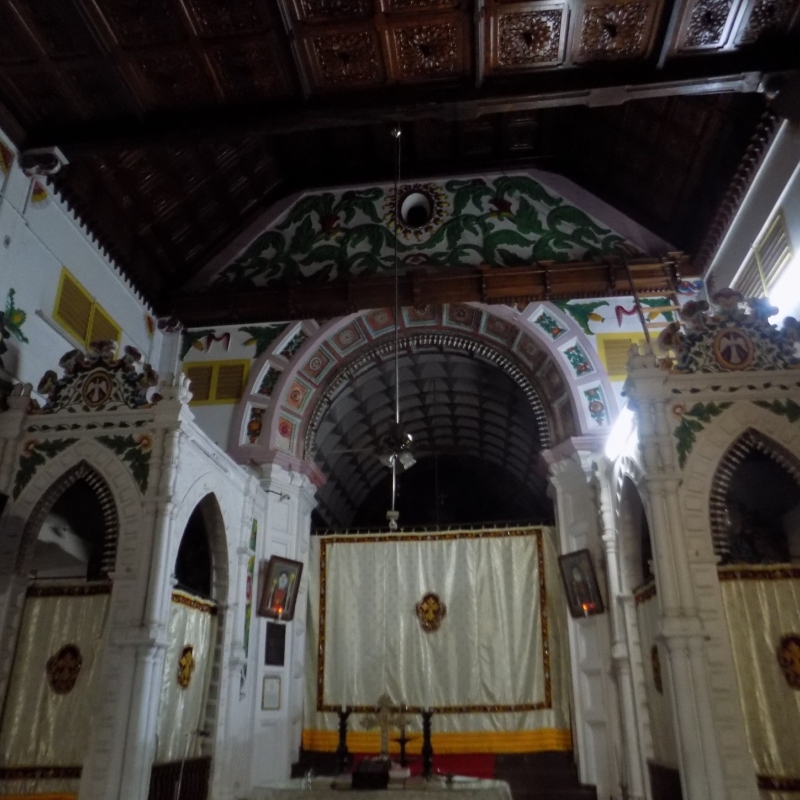Kerala has a thriving Christian community and the church claims a tradition that is almost contemporary to the founders of the religion. Architectural evidence and archaeological evidence for a thriving commerce with West Asia, Egypt and other centres of early Christianity are emerging from the Malabar Coast. Perhaps, church art and architecture have been flourishing since then.
Christian art includes murals, plaques, furniture, ivory, paintings, textiles, metal objects, wood icons and miscellaneous objects. In this article, an attempt is made to make broad comparisons between the church murals in Kerala and the paintings in select churches in other parts of the western coast of India where there has been Portuguese influence in Christian art. A careful analysis shows that in the churches in Kerala, we find Indo-Christian mural art. This article discusses the spatial and temporal context of the murals. The approach is regional and comparative.
Spatial Context
Murals are found in around a hundred churches in Kerala and they date from the thirteenth century to the present. The prominent ones are listed here (Table: 1). Very few predate the Portuguese, who reached the coast during the fifteenth century CE. The majority of the murals studied here can be dated from the early seventeenth century to the end of the nineteenth century.
|
1 |
St Mary's Catholic church |
Champakulam |
Alapuzha |
|
2 |
St Thomas' Jacobite church |
Karthikapalli |
Alapuzha |
|
3 |
St Thomas' Jacobite church |
Karthikapalli |
Alapuzha |
|
4 |
Mar Sabore, Afroth Jacobite |
Akaparambu |
Ernakulam |
|
5 |
St. Mary’s Jacobite church |
Angamali |
Ernakulam |
|
6 |
St Mary's Catholic church |
Kanjoor |
Ernakulam |
|
7 |
St Peter and Paul's Jacobite church |
Karamala |
Ernakulam |
|
8 |
St. Thomas Catholic church |
Malayattur |
Ernakulam |
|
9 |
Marthoman Jacobite church |
Mulanthuruthy |
Ernakulam |
|
10 |
Martha Mariyam Jacobite church |
Pallikkara |
Ernakulam |
|
11 |
St Thomas Jacobite church |
Piravom |
Ernakulam |
|
12 |
St George Orthodox Church |
Cheppad |
Kollam |
|
13 |
St Peter's Catholic church |
Moorthakara |
Kollam |
|
14 |
St Mary's Orthodox church |
Kottayam Cheriyapalli |
Kottayam |
|
15 |
St. Mary’s Catholic church |
Lalam |
Kottayam |
|
16 |
St Sebastian's Catholic church |
Muttuchira |
Kottayam |
|
17 |
St. Augustine’s Catholic church |
Ramapuram |
Kottayam |
|
18 |
St. George Jacobite church |
Paliekkara |
Pathanamthittta |
|
19 |
St. Mary’s Catholic church |
Koratty |
Trissur |
|
20 |
St. Antony’s Catholic church |
Ollur |
Trissur |
|
21 |
St Thomas Catholic church |
Palayur |
Trissur |
|
22 |
St Mary's Orthodox church |
Pazhanji |
Trissur |
|
23 |
St. George Catholic church |
Angamali |
Ernakulam |
Table 1: Churches in Kerala with old murals (Peter and Gopi 2009)
Church murals usually adorn the interior walls of the church. Murals are more common on the interior walls, ceilings and pillars of the various parts of the church such as the pulpit, altar, sanctuary, chancel, nave and aisles. Murals on the exterior of the church are very few and found in the niches of the façade and above the arched gateways, as seen at St. Sebastian’s Church, Kanjoor.
Time Context
We have the earliest murals in the temples of Kanyakumari district in erstwhile Travancore, dating back to the early medieval period, from the ninth to twelfth centuries CE. The oldest church murals are found in St. George Orthodox Syrian Church at Cheppad in Alapuzha district and are dated to the thirteenth century CE.
The mural is the predominant type of wall painting seen in three different spatial contexts in Kerala: temples, churches, and palaces. We can see broad similarities in techniques, but differences in themes and purpose, with a few exceptions. The church murals in Kerala have been compared to those in the churches of Goa, Mangalore and Mumbai on the Konkan coast. This gives us a fair control in dating the church murals of Kerala. Sub-regional variation is seen among church murals in Kerala but these are not discussed here.
Dating church murals is a challenge as only broad time frames are available. We can divide the period during which church murals were executed into five. This classification is based on the detailed comparative analysis of the church murals in Kerala with a) temple murals of the early and late periods, b) church murals in Goa belonging to the early and late Portuguese periods, c) the murals in Mattancherry palace belonging to the late seventeenth century CE, d) the nineteenth-century paintings by Moscheni in three churches, mainly the one in Mangalore in Karnataka and e) the murals of the modern period, mainly the twentieth century CE. The following periodisation is proposed for the church murals in Kerala:
- Pre-Portuguese tradition (c. 1000-1200 CE)
- Portuguese tradition (c. 1500-1700 CE)
- Early Portuguese (c. 1500-1600 CE), considered the Golden Age of Portuguese paintings
- Late Portuguese (c. 1600-1700 CE)
- Dutch tradition (c. 1700-1800 CE)
- British tradition (c. 1800-1900 CE)
- Modern tradition (c. 1900 CE onwards)
The Pre- Portuguese tradition is referred to as the Romanesque period in the history of Christian art and involved massive scale and realism. This period is devoid of naturalism and humanism and linear designs predominate.[1] This can be seen as a bridge between eastern Byzantine art with its symbolic, formalised icon painting and the late fourteenth century variant of western Gothic art known as the International Gothic. In general, Romanesque art reflected the rise in political and economic stability across Europe. Apart from stained glass art, many fresco paintings were done during this period. Seminaries opened by the Benedictines and others around the world needed inspirational mural paintings in their cloisters and refectories. This reflected the growth of monastic piety. The churches in Kerala were no exception to this as can be seen at Cheppad church in Paliekkara. The dating of this period can be done by studying the style and iconography. However, as a large number of paintings of the early period have been destroyed dating murals in churches remains a challenge.
The murals in churches open up a number of possibilities. They help in dating the church itself, where direct evidence for the founding of the church through inscriptions and tombstones are absent. This is done in comparison with other artefacts and other churches and local history. Mural artists rarely leave their mark on church murals unlike the temple murals in Kerala which have been studied more extensively. Interestingly, on top of the big arch in the sanctuary of St. Aloysius College Chapel, Mangalore, there is an inscription in Latin which suggests that the church was adorned with gold and paint at the close of the nineteenth century CE. Nearly 1000 sq. metres in this chapel is filled with murals. Recently, more scientific dating techniques have been employed for dating murals. Apart from comparative dating techniques, there are stratigraphic studies of the layers of murals in churches in Egypt and Western Europe. This allows comparisons to be made of the ground layers, pigments and binders.
The paintings in the churches in Old Goa were characterised using complementary analytical and imaging techniques, such as X-Ray Fluorescence spectrometry (XRF), Infrared Reflectography (IRR), Infrared Photography (IRP), Macro Photography (MP), Micro X-Ray Diffraction (µ- XRD), Scanning Electron Microscopy with Energy Dispersive Spectroscopy (SEM-EDS), Raman micro-spectroscopy (µ- Raman), Fourier Transform Infrared micro-spectroscopy (µ- FTIR) and Pyrolysis gas chromatography-mass spectrometry (PY-GC/MS). It helped to conclude that the paintings were a product of the Lisbon workshop in sixteenth-century. The church murals in Goa are fairly well dated as churches were built in Old Goa within a short span of two hundred years. Such attempts have not been made in the case of church murals in Kerala as it spans broader time frames.
St. Aloysius College Chapel in Mangalore, built in 1882 CE, has post-Renaissance murals. It is the largest repository of church murals in India and, hence, is often referred to as the ‘Sistine chapel of India’. Due to its proximity to Kerala and its location on the Konkan coast, these murals are important in contextualising the church murals in Kerala. The entire chapel, covering a total area of 829 sq. metres is painted. Frescoes cover about 600 square metres of the walls of the chapel. All these were executed in a short single span of two and half years by an Italian master painter-cum-Jesuit missionary, Br. Antonio Moscheni, and have been conserved fairly well. He commissioned frescoes in three churches in India, the other two being the Holy Name Cathedral, Mumbai (Fig. 1) and Santa Cruz Basilica in Cochin, but died before he could complete his work in Cochin. These three are among the well-dated murals in the churches in India and belong to the late seventeenth century CE.
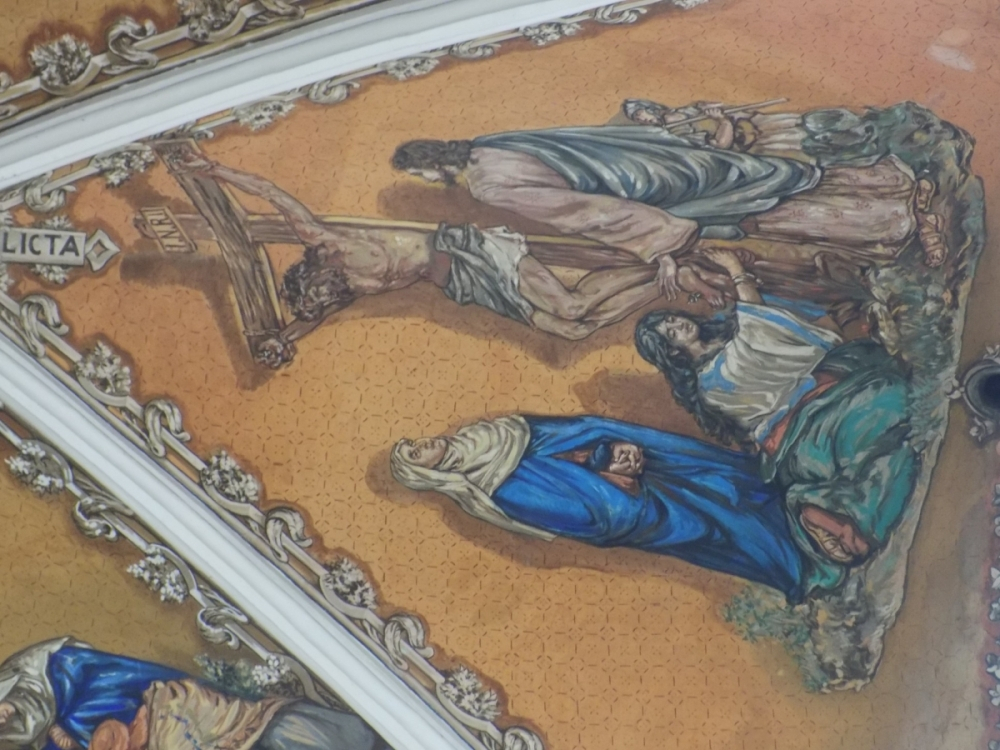
Church murals give clues on contemporary social and political history. In a painting in St. Aloysius College Chapel, St. Britto is shown converting a queen of Cochin. This conversion caused tension between the Jesuits and Sakthan Thampuran, the ruler of Cochin from 1790 to 1805 CE. A panel in St. Sebastian’s Church, Kanjoor used to show the battle between the army of Tipu Sultan and the combined forces of the Travancore State and the English East India Company around the same period. After this historic battle, the church was restored and the ruler of Cochin donated a bronze lamp and land to the church. The original mural was destroyed when the church was rebuilt and now what we see in the church is a modern mural copied from the facsimile copy kept in the Cochin State Archaeological Museum in Thrissur in the 1930s. The painting covers an area of 200 sq. feet and has been executed in indigenous Kerala style.
Murals also represent the trajectory of Christianity in Kerala. The churches in Kottayam, Alappuzha, Trissur and Ernakulam have visually represented the arrival and missionary activity of St.Thomas. The process of acculturation of the church is visible in these representations that show groups of local Brahmins being converted to Christianity. An elephant is prominently displayed to show the landscape of Malabar in the murals at Mulanthuruthy and Cheppad, to name a few. In a way try to legitimise the St. Thomas tradition, these murals were executed much later and can be dated between the sixteenth and eighteenth centuries CE. By this period, the indigenisation and acculturation of the church in Kerala were more or less complete. Though church art was promoted by Western missionaries, it already had a long history and was indigenised and consolidated by the seventeenth century.
The Jesuit Context
This takes us to the next aspect in contextualising the church murals in India, and that is the role of Jesuits. Jesuit impact on church murals in Kerala has not been well established. The Mughal court paintings had depictions of angels which was a Christian device introduced by the Jesuit missionaries from the seventeenth century onwards (Fig. 2). The Jesuits contributed significantly to church murals in Goa and Mangalore, mainly through the works of Garcia Fernandes (1514-1565 CE) and Antonio Moscheni (1854-1905 CE). The chapel of St. Aloysius has murals reflecting Jesuit philosophy and the biographies of the prominent figures in the Order of the Society of Jesus.
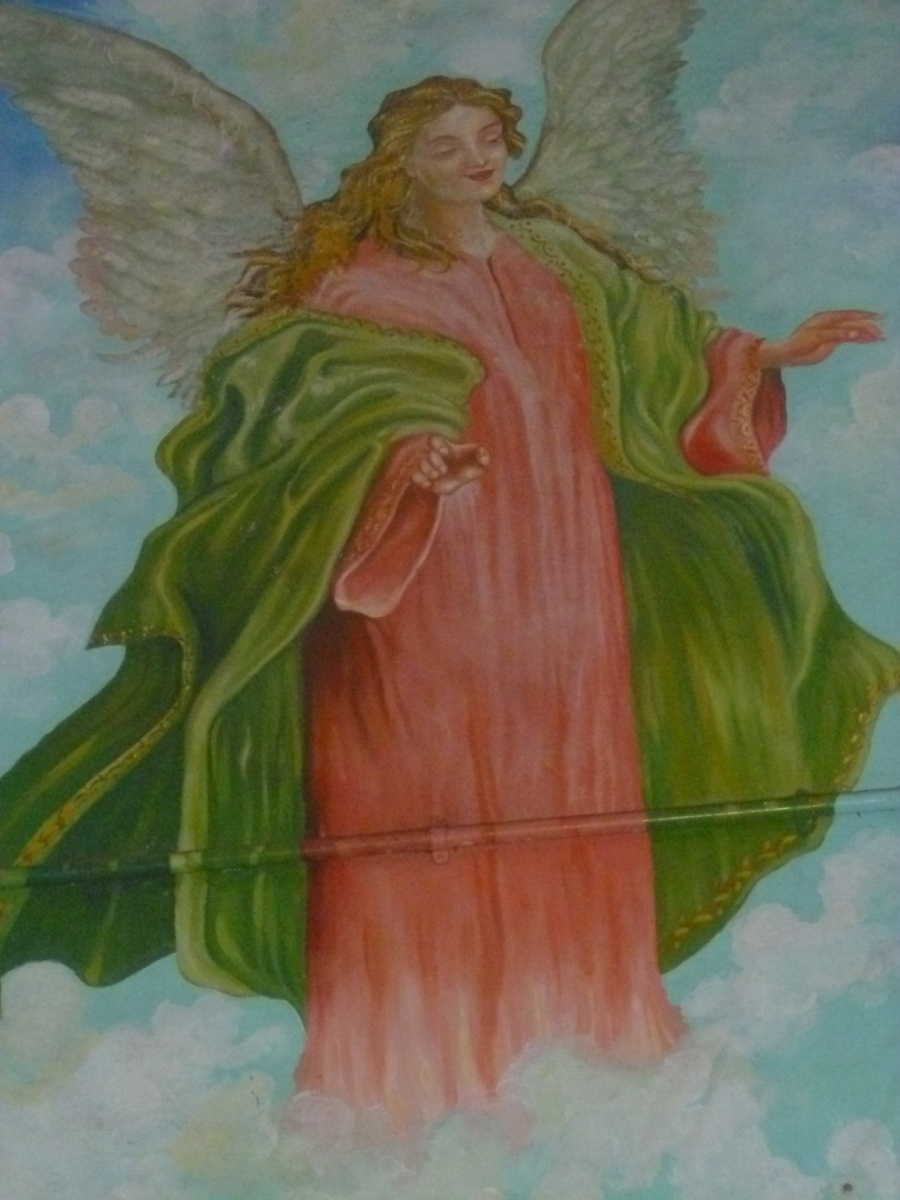
In the murals in St. Aloysius College Chapel, patron St. Aloysius is depicted prominently. St. Ignatius Loyola and St. Francis Xavier, with devotees invoking their intercession, are shown on the left aisle. In the murals, the central theme is Mission. The murals give a detailed history for public view through the paintings of the blessed and the saints who became martyrs in the course of their work for the Jesuit mission in different parts of Asia, mainly India, China and Japan. The Arch R.2 shows an Italian man, who was held in high esteem but was later killed at Salcete, Goa, in the court of the Mughal Emperor Akbar.
We can also understand the process of missionary acculturation in the painting of Simon de Britto, the Portuguese missionary who lived in the sixteenth century in St. Aloysius chapel in Mangalore and Santa Cruz Basilica, Fort Cochin. St. Britto lived and worked in Kerala and studied in the Ambazhakkad seminary near St. Francis Xavier’s church, Sampaloor. Though texts of the period focus on the brutality of the Portuguese and the persistence of the missionaries in spreading Western thought in India, murals in the churches contrast this picture. Hence, Jesuits contributed to church art and architecture in Kerala since the seventeenth century. The Jesuit churches on the west coast of India, such as in Goa and Kerala, seem to have preferred murals more as an agent of public display than the Carmelite and Franciscan churches.
Technique
The mural is a generic term that refers to wall paintings, or composite forms of art done with lime wash and natural pigments. The three broad techniques of murals are a) fresco/ Buon fresco b) fresco al secco/ fresco secco, and c) distemper, oil-based Fresco secco, is a complex technique derived from the earlier fresco tradition.
Weather and humidity played a major role in the preference of fresco secco over others in Indian churches. The increased incidence of salinity and humidity and tropical weather has deteriorated the paintings in the churches of Goa, Mangalore and Cochin and their conservation is a major challenge.
A fresco uses water-based paint and is done on fresh lime plaster. Frescoes are done while the lime coat applied as the base for the painting is still wet and, hence, have to be executed speedily. In frescoes, artists use colours made by grinding dry-powder pigments in water. The colours get embedded in the lime plaster as it dries up. Fresco painting is ideal for making murals because it lends itself to the style of the monument and is durable. Moscheni, who painted frescoes in the Santa Cruz Cathedral, Fort Cochin, writes in his letters how carefully he planned each series by sketching in his book before executing them. Outlines could be drawn only after the lime plaster was applied. Perhaps, another coat of lime was applied while the painting the mural.
In Europe, the fresco technique was first used in churches by the Renaissance artists from the fourteenth to the sixteenth centuries CE. In many parts of Asia and Africa, fresco tradition is much older. In India, the earliest preserved frescoes have been found in the Ajanta group of caves in western India which are dated to the period between the second century BCE and the fifth century CE.
The churches in Goa and Kerala have many murals in the fresco-secco tradition. They use water-based paint mixed with egg-white or glue made from fish bones or rabbit skin. They are done on dry plaster walls that have been wetted with lime wash. Fresco al secco is done after the lime coat applied on the wall is dry. The brushes, techniques of drawing, and pigments used are more or less the same in both these techniques. Since Fresco secco is the technique used in church murals, these are commonly referred to as murals. This technique was most commonly used during the medieval and early modern periods. The careful preparation of the surface of the painting is an important feature of a mural. Tempera is used mainly in doing the wooden panel paintings such as altarpieces in the churches which are found along with the murals (Fig 3, 4). Like fresco it is water-soluble. It was superseded by oil paintings in Europe during the Renaissance.
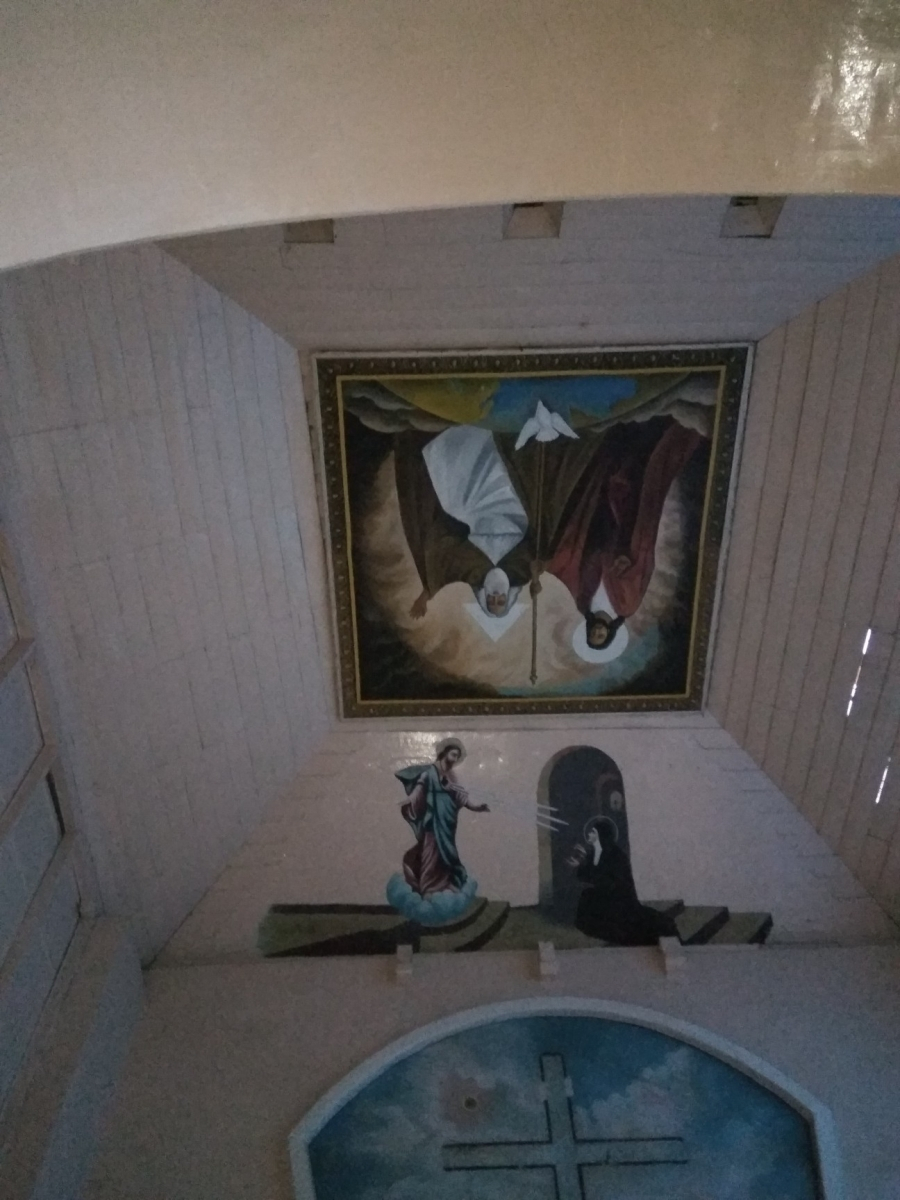
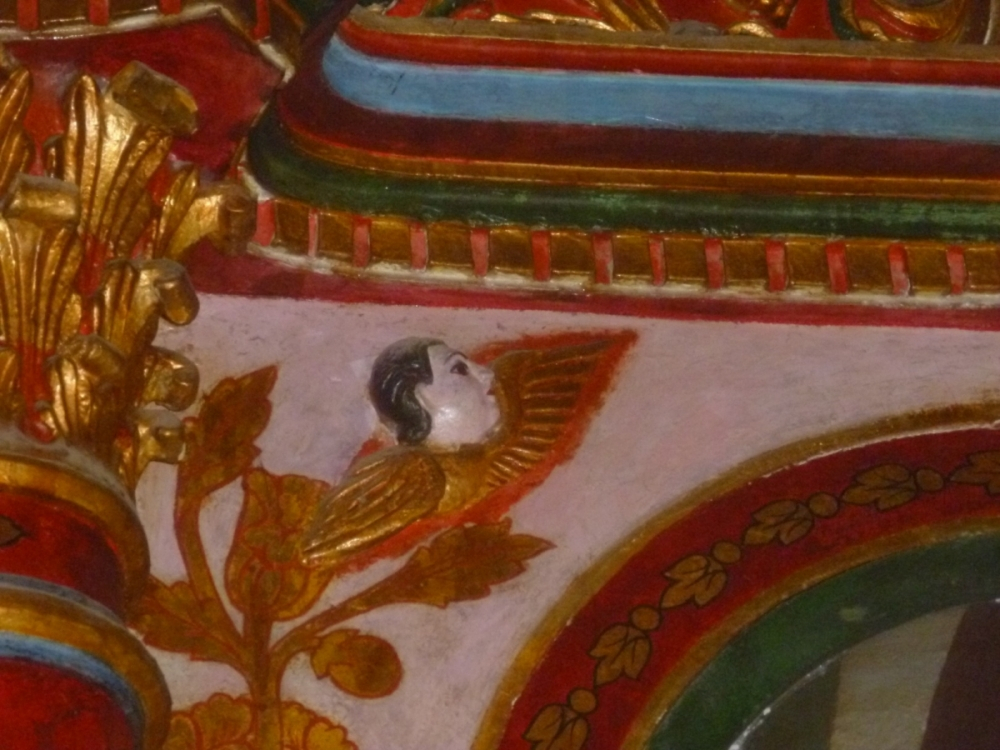
The mural is any large painting on a wall, ceiling and fresco is its most popular technique. Wall paintings vary from prehistoric rock art to modern wall graffiti. But, in murals the surface of the painting involves careful preparation in the form of lime coats.
Church and Temple Murals in Kerala: A Comparison
The church murals in Kerala are distinct from the temple murals in three aspects - theme, style and colour scheme. Palaces at Mattanchery, Krishnapuram and Padmanabhapuram and temples at Ettumanur, Vaikkom, Pundarikapuram, Trichakrapuram, Thodeekalam and Pandavam are richly endowed with mural paintings. Temples have murals on the outer walls of the sanctum and the inner walls of the circumambulatory path. The churches have paintings on roof and walls. Apart from murals, there are wooden panels and oil paintings on canvas or linen which are then mounted on the roof in churches. Artists preferred paints imported from Europe for the canvas and wood panels in churches but this was not practical for the murals, which covered a large area. The murals were done using locally available pigments. Moscheni used to prepare them himself using vegetable dyes. Temple murals is Kerala used vegetable dyes and organic/inorganic pigments exclusively. These were used also in the church murals of the region. Blue is rarely used in the colour scheme in temple murals whereas it is a prominent colour used to depict Jesus and St. Mary in the church murals. From the seventeenth century, oil paintings began to appear in the churches in Kerala. Gilt dominated church paintings in Goa during the early Portuguese period. Gilt is not so prominent in the church murals in Kerala. Cobalt blue is prominent in murals, but these could be post- seventeenth century. Alternately, blue could be from a vegetable dye from the Nil Amari plant or from lapis lazuli, a mineral imported from Afghanistan.
The temple murals are highly formalised and follow a certain degree of standardisation towards the later stages in contrast to church murals. Highly formalised and elaborate tradition is reflected in the murals of the Dutch Palace in Mattancherry as well (Ernakulam district).
Church Architecture
Church architecture forms the backdrop church murals. In the seventeenth century, there were quite a few innovations in church architecture. Following the Synod of Diamper in 1599 CE, existing churches were rebuilt with prominent facades (Fig 5). From the late seventeenth century CE a number of churches were built in the Gothic style with high ceilings. As churches in Kerala have high ceilings, murals found on them could be executed only with scaffolding. Most of these churches also had vaulted ceilings which made the execution of the paintings difficult.
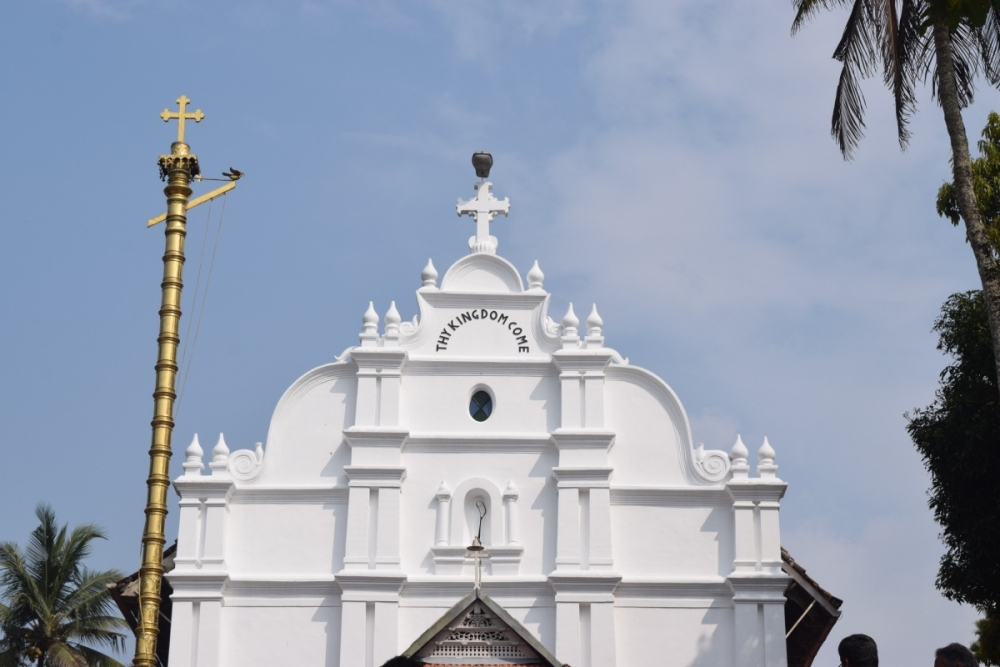
Thematic Context of Church Murals
Catholic chapels and churches in India have used murals extensively in their public display of faith. Paintings include universal Christian themes based on the Old Testament and the New Testament of the Bible. Larger paintings and central paintings, particularly in the altar, depict Christ, St. Mary and the Holy Trinity in the churches in Angamaly, Akaparamabu and Cheppad to name a few (Fig 6). In the St. Aloysius chapel, the Apostles Series is showing the apostles with their iconic devices. Likewise, as St. Thomas is the patron saint of the Syrian church in Kerala, he is shown with prominence. Peter, the first apostle, and St. Paul are also prominently shown. There are other themes like the Saints’ Series. The life history of the patron saint of each church is visually presented through the paintings. Local myths also find a place in church murals such as the conversion of Brahmins by St. Thomas found in the sanctum sanctorum of the churches at Cheppad, Pazhanji and Mulanthuruthy. These are found in the nave that is the space for the lay devotees. These belong to the later period from the seventeenth century onwards. The common themes in church murals are Nativity (visit of the shepherds), presentation of Jesus in the synagogue of Jerusalem, baptism of Jesus in River Jordan by John the Baptist, cleansing of the Temple, the first miracle at the wedding feast at Cana, the Passion of Christ, the crucifixion and resurrection of Jesus (Guide to the Chapel 2012). These are universal themes in Christian iconography and vivid examples can be seen in the churches in Kerala.
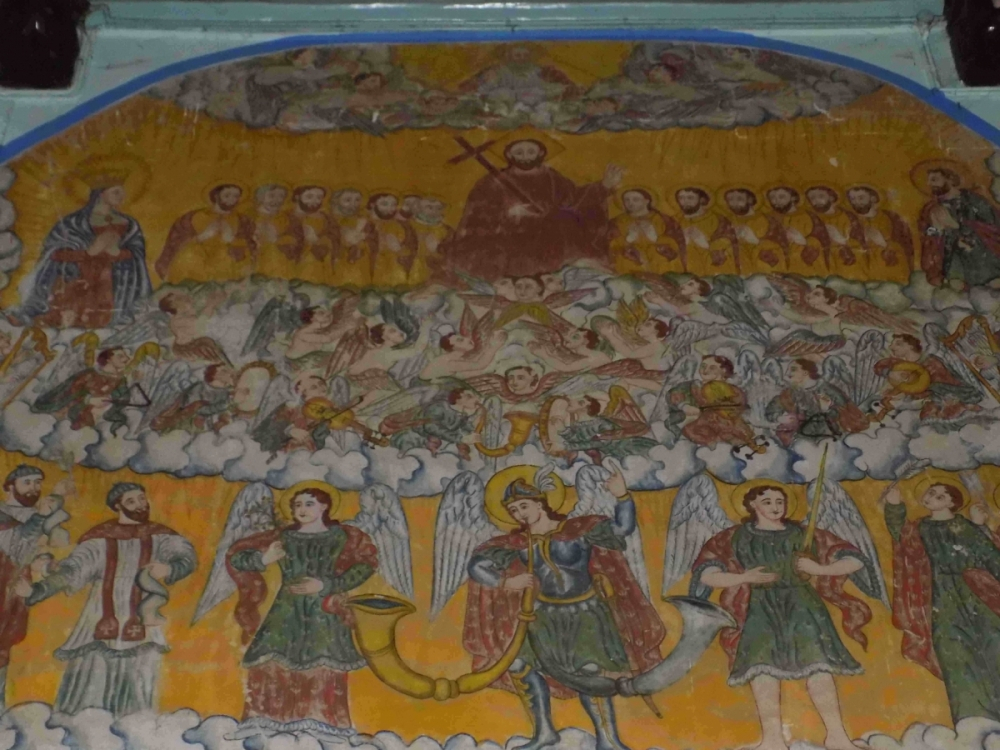
Church murals aim to create piety through paintings and narrate the history of Christianity through themes like the Apostles series, Saints Series, the Trinity and the life of Christ to name a few. The differences among the murals in each church will depend on their purpose (seminary, convent chapel, cathedral church, cemetery church) and the Order (Benedictines, Jesuits, Franciscans) and the cultural tradition (Portuguese, Indo-Portuguese) they represent.
No two churches are alike in their wall paintings. Even those by the same artist show considerable regional and sub-regional variations. Sixteenth-century was the Golden Age of Portuguese painting in Goa as numerous church murals were commissioned in this century. But the majority of church murals in Kerala date from the seventeenth century or after the Synod of Diamper. A more liberal presentation is seen in church murals in the eighteenth and nineteenth centuries with the introduction of the Indo-Portuguese style in addition to the Portuguese style. Paintings in the churches in and around Fort Cochin and Vypin seem to have been strongly influenced by Portuguese style. Garlands weave through the panels in the churches in Kerala. No two garlands have the same flowers which is a signature style of Moscheni of the late nineteenth century. In the earlier period, uniformity was the order and not diversity. Grapevine is a common theme as at the St. Mary’s church in Alangad (Ernakulam district). The angels usually hold these garlands. In later murals, they are life-size. These show the effective use of proportions and perspectives by the artists (Fig. 7).
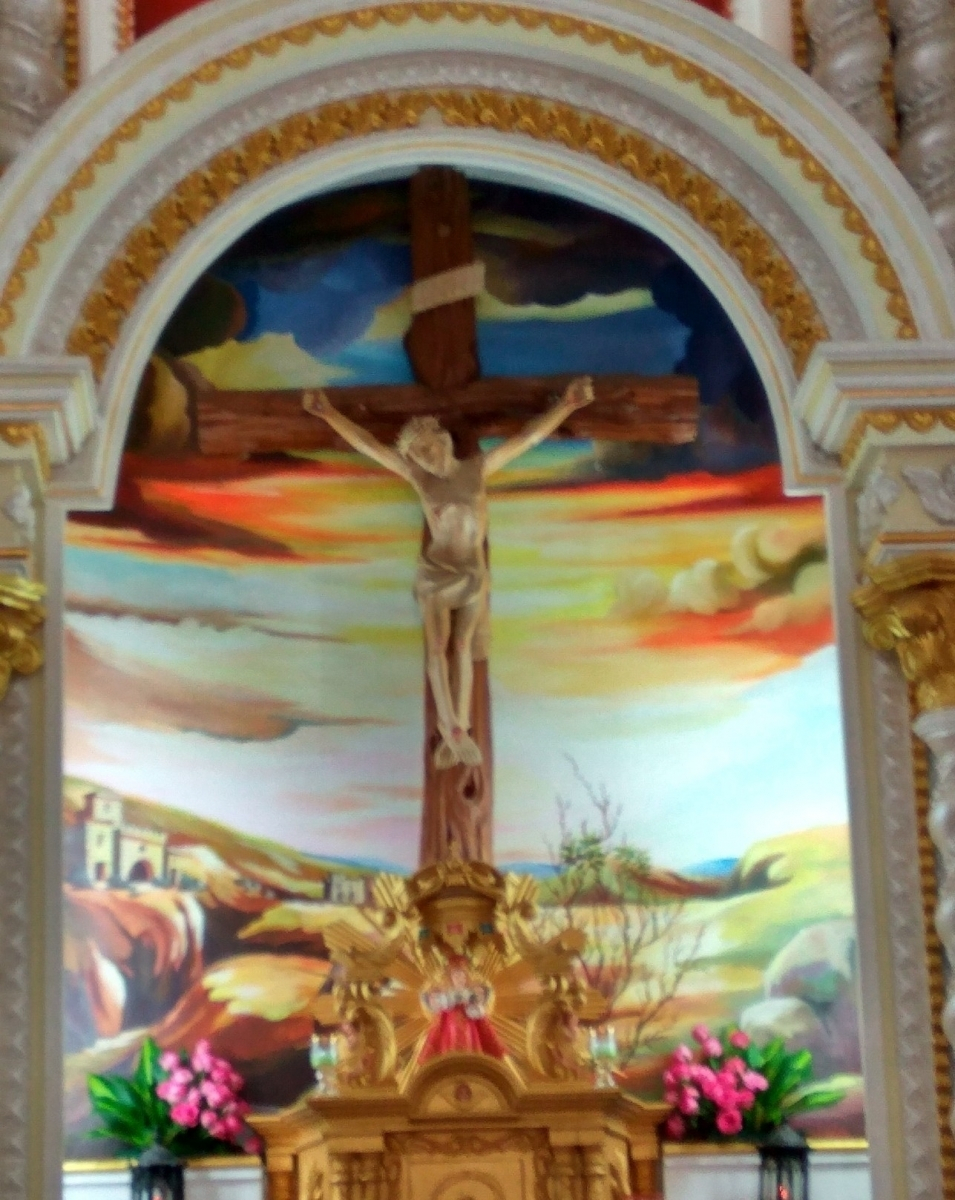
Discussions on Church murals are meaningful only when their context is well examined. The context of the paintings in a college chapel or convent is different from the faith and piety intended in a pilgrim centre and both evoke different meanings.
The apostles are depicted in a non-sectarian manner in most church murals but there are sub-regional differences in their appearance. Five apostles who figure most frequently in churches in Kerala are St. Peter, St. Paul, St. John, St. James and St. Thomas. St. Thomas is considered the patron saint of Kerala and figures prominently in church murals with considerable differences in the colour schemes and background. The best examples are from St. Thomas Church, Malayattur; Mar Thoman Church, Mulanthuruthy; St. George Church Cheppad and Mar Thoman Church, Paravur. Apostles can be identified from their devices - rooster, keys (St. Peter), spear, hand on the wound of Christ (St. Thomas), and sword (St. Paul).
However, the murals in the catholic churches, done in the seventeenth, eighteenth and nineteenth centuries, tend to have their patron saints like St. Sebastian (Kanjoor, Arthunkal) and St. Antony (in Old Goa). The depictions of St. Sebastian are very common among the church murals in Kerala. He is shown as a martyr shot with arrows and his portrayal is found in both murals and icons. This saint is very popular in Kerala, particularly in the coastal regions of Alapuzha and the myths about him are highly indigenised, while the murals and icons follow conventional church iconography. The church at Arthunkal in Alapuzha district is the best example in this category. The mural depictions of St. Sebastian are as numerous as his statues found in almost all the catholic churches in central and southern Kerala. However, unlike the icons, the murals offer a bigger canvas and local themes are painted around the saint who is shown in his usual devices particularly in the form of a martyr. This image is enacted during the feast of this saint, a practice that is highly popular in the regions mentioned above.
The murals in the churches in Kerala are the creations of various artists and have distinct dimensions of time and space. These translate into subtle and sometimes pronounced differences in the pose, expressions and the colour schemes used and can be clearly seen in the case of the murals of St. Sebastian. In the churches in Alapuzha district, the saint is popularly known as veluthchan (white priest/saint) suggesting that this form of saint veneration was strongly acculturated and, as a result, this cult became even more popular and rooted. Hence we can state that St. Sebastian is the most acculturated in Church iconography in Kerala.
St. Antony (Anthony/ Antonio) is one of the patron saints of Portugal. The narrative about this saint is more or less similar in India too. Jesus is said to have appeared to him as a child. He died in the thirteenth century and is dubbed the ‘Doctor of the church’. While St. Sebastian was acculturated, in the case of St. Antony, the Portuguese built many churches or renamed churches in the coastal regions near ports and harbours in the districts of Ernakulam, Alapuzha and Kollam after him. In Church iconography, he is considered as the healer and wonder worker. There was a convent of Carmelites attached to the church of St. Francis Assisi in Old Goa which is at present a museum under the Archaeological Survey of India. Near the entrance to the museum, on the right, there is a mural with St. Antony on one side and a group of nuns on the other side (Fig. 8). But in the Carmelite churches in Kerala, very few murals are seen.
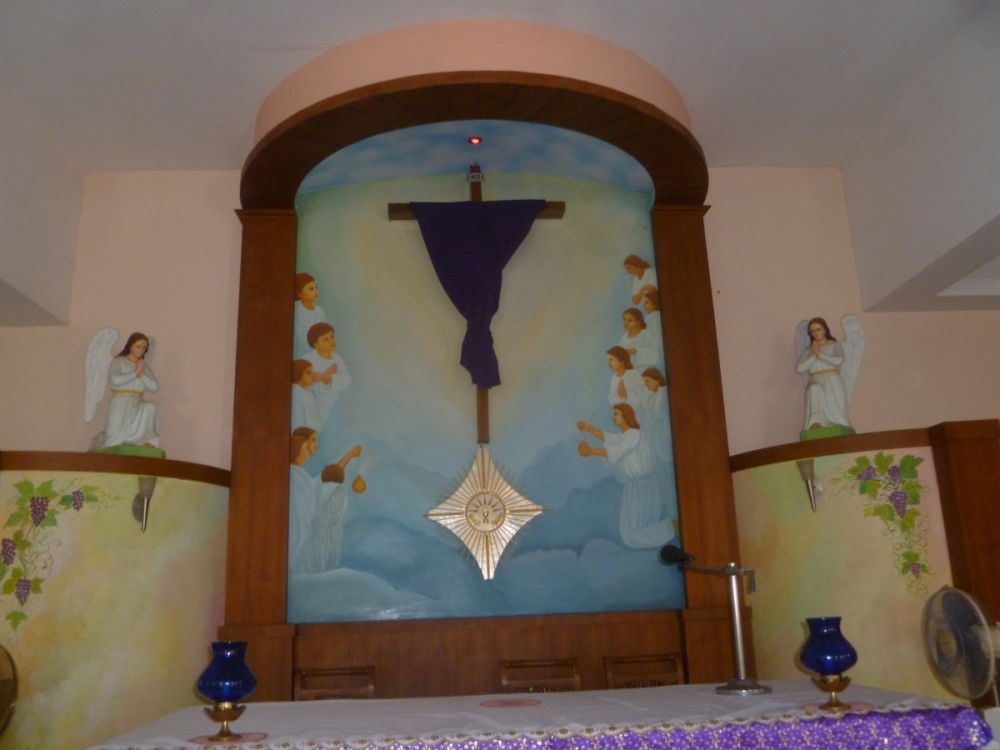
St. Francis of Assisi was the founder of the Franciscan Order which was active in proselytisation in the early years of Portuguese contact in Asia. Church iconography considers St. Francis of Assisi as the patron of environmentalists and hence he is shown with animals around him. Mural depictions of St. Francis of Assisi are found in a few catholic churches in Kerala.
Like St. Sebastian and St. Antony, St. John De Britto was a patron saint who was popularised through church art in Kerala by the Portuguese. Unlike St. Sebastian and St. Antony, St. Britto and St. Francis Xavier were Jesuit missionaries and contemporaries who worked in Asia and spent considerable time in Kerala doing missionary work. Britto spent his formative years as a missionary in Ambazhakkad seminary near Kodungallur in Kerala. He was the first missionary to adopt the robe of a sanyasi as a sign of enculturation of the Church. He also studied Tamil and Sanskrit to understand the local culture and adapted it to his mission. As already mentioned, he converted the queen of Cochin and was put to death by the order of the king of Cochin and became a martyr.
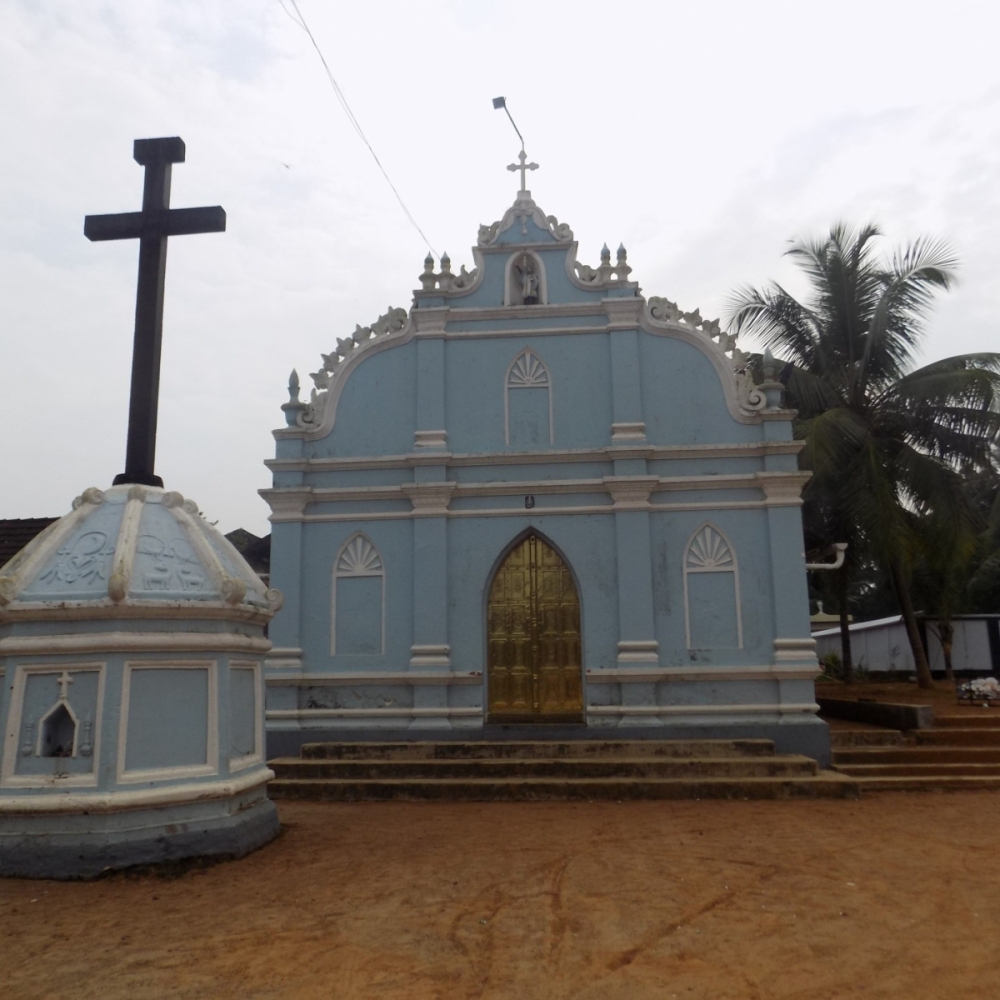

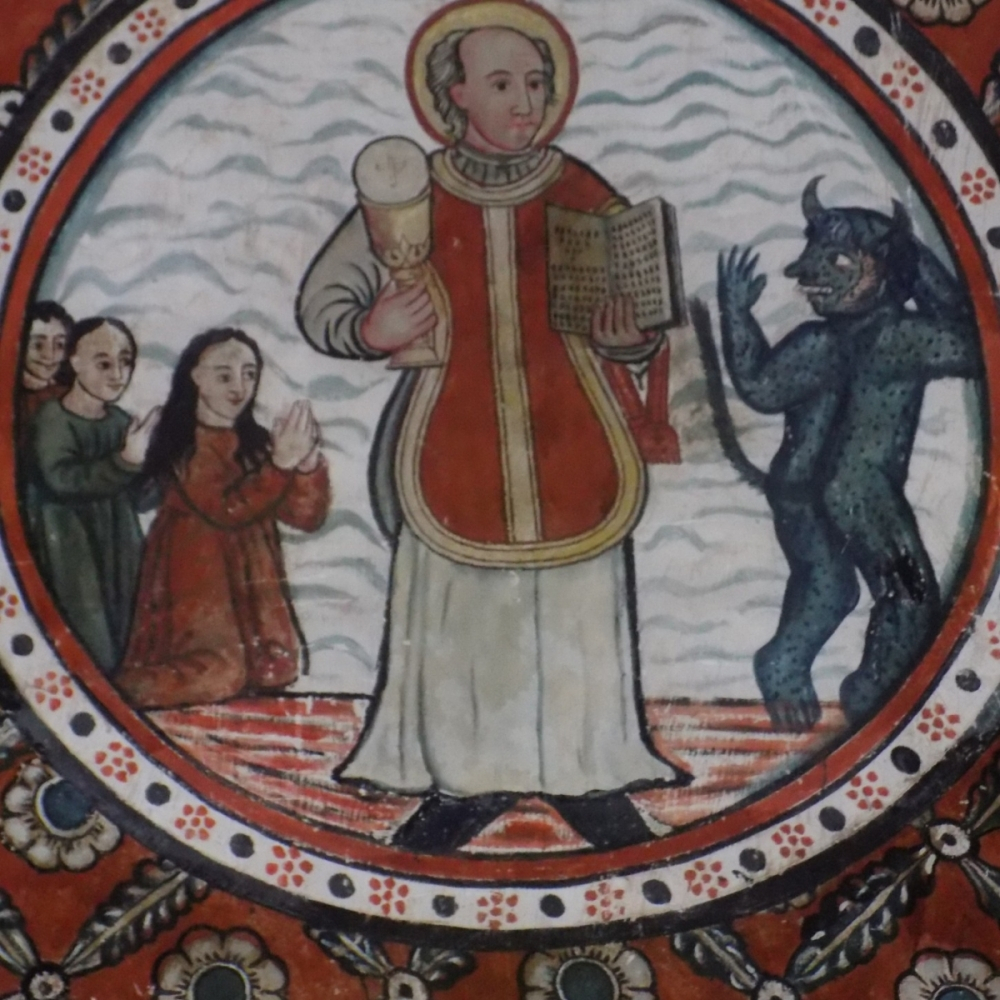
Modern Murals
In the twentieth century, churches continued to be built and painted. However, these paintings were not done by master artists like Moscheni. These murals were poor replicas of earlier ones. Synthetic paints, distemper based paints, and acrylic replaced natural material as they are easy to work with and cheaper. Synthetic paints were used extensively to repaint or re-touch the old paintings. This happens with the annual church festival. In a few churches, old murals have been entirely white-washed over.
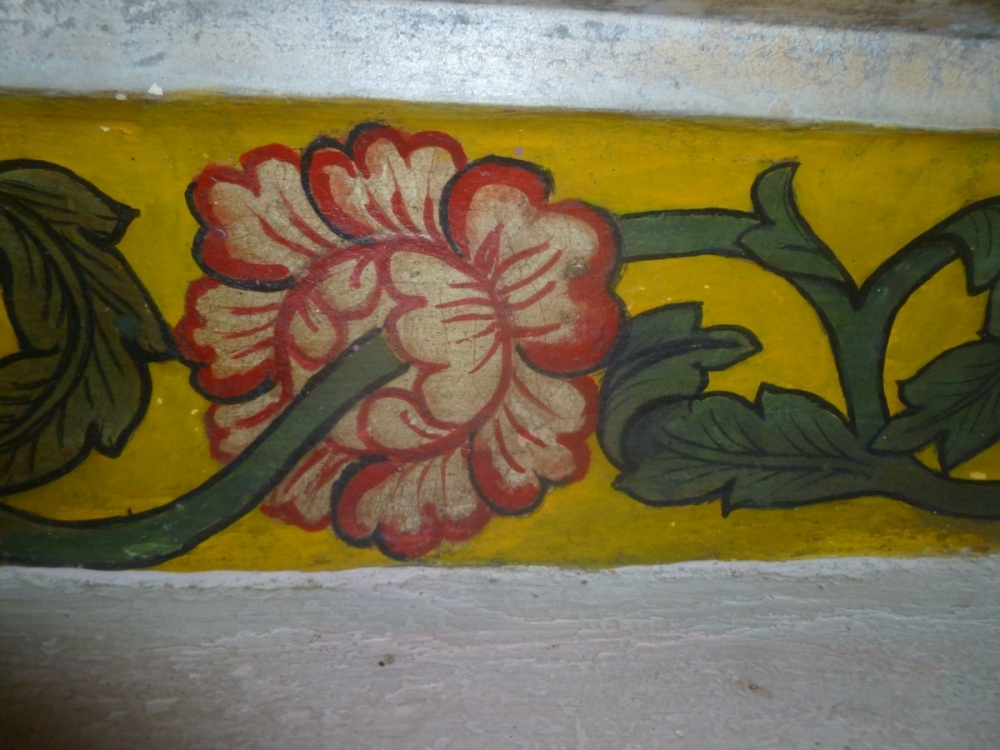
Many old churches were extensively renovated or demolished in the twentieth century and numerous murals were lost, few of them being St. Mary’s church, Koratty; St. Mary’s church, Chalakudy; St. Sebastian’s church, Vallom; and St. Sebastian’s church, Kanjoor.
From the late twentieth century, there has been a revivalism in church murals. Murals in St. John’s Orthodox church (Pampakuda Valiyapalli) near Piravom (Ernakulam district) built in the late eighteenth century were done only in 2016. In Goa, paintings are seen only on the walls and ceiling of the sanctuary. But in Kerala, murals belong to different phases and murals are found not only in the sanctuary (chancel) but also in the nave in the case of both old murals as well as modern murals.
Paintings On The Nave
In most churches, a different genre of paintings can be seen on the arches of the nave. In the Mangalore chapel, the Patriarch and early Fathers of the church mentioned in the Old Testament are shown. In the old churches of Kerala and Goa, the arch has stucco work and geometric designs in bold colours.
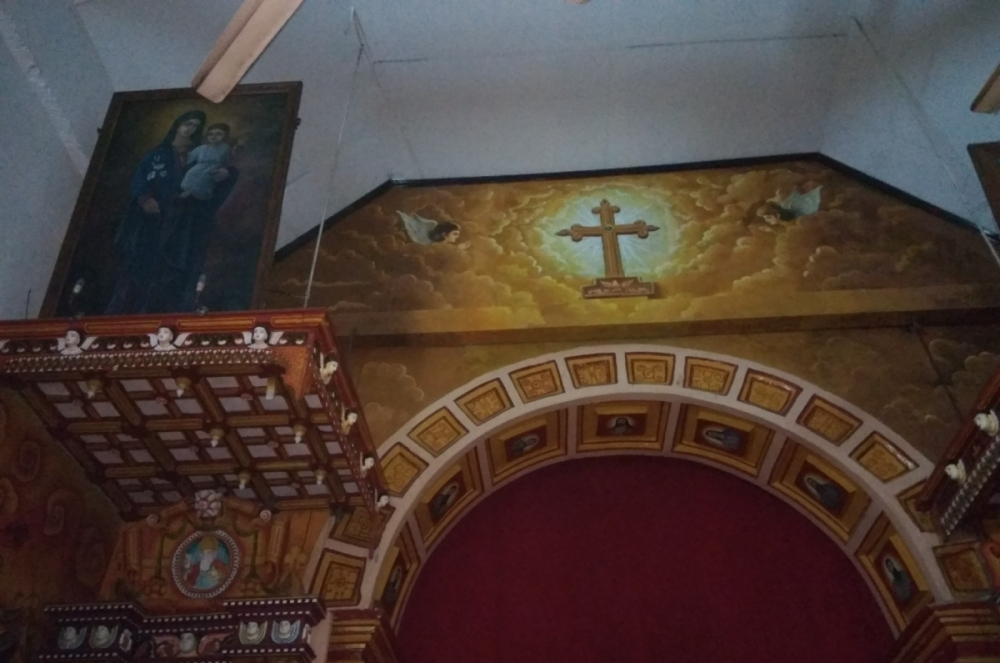
Many of the old churches in both Old Goa and Kerala follow a similar pattern in architecture and show the Portuguese influence. These churches are now dwarfed by the massive churches built later and can be seen at Udayamperoor, Edapally and Ramamangalam.
The nave and altar wall paintings are the most significant examples of church murals in Kerala (Fig 14, 15, 16). They are usually divided into three registers with the middle register showing Christ and the others showing the saints. The two side registers are used to paint saints and local traditions. Secular themes are executed on the outer walls.
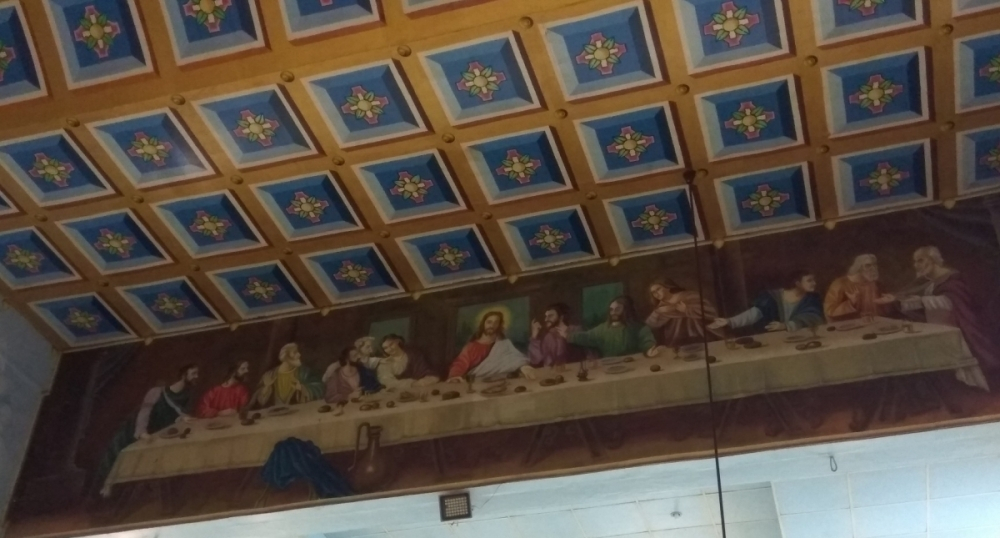
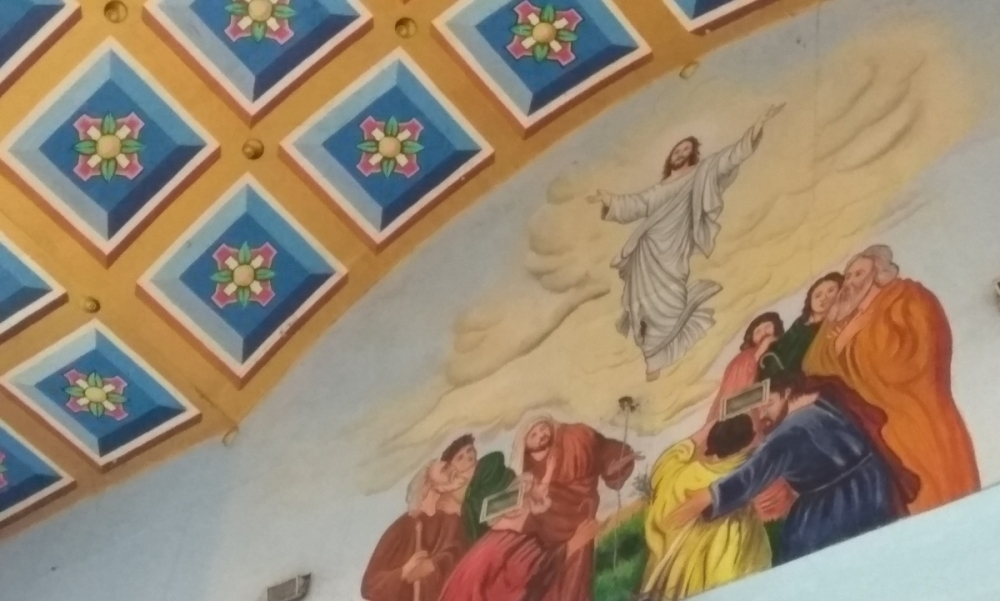
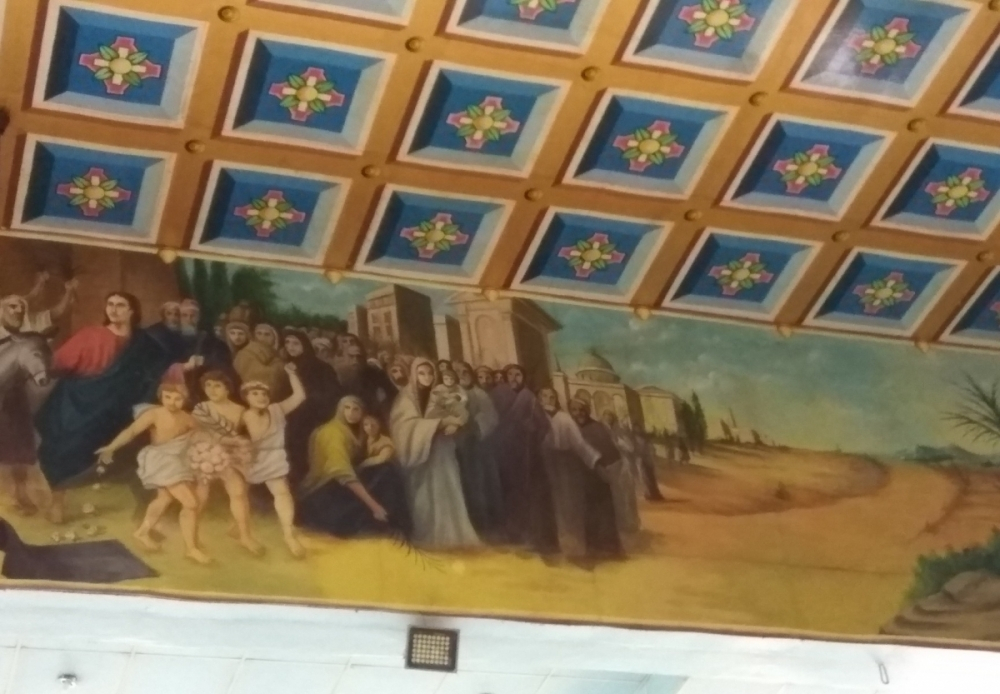
Depiction of Women in Church Murals
Women are seldom represented, with the exception of St. Mary, St. Mary Magdalene and St. Martha. The latter two mainly appear in the crucifixion panels. At the St. Aloysius College Chapel, there is a painting of St. Teresa of Avila who reformed the Order of Carmel for Women. She was a great mystic and her heart was pierced by an arrow of divine love. Most catholic churches, convents, seminaries and chapels in Kerala have icons of St. Teresa of Avila and there is a famous shrine in her name built by the French in the late eighteenth century at Mahe, a part of Puducherry, close to Kannur in the northern part of Kerala. This church was originally built in 1736, reconstructed in AD 1788, renovated in 1956 and again in 2013. The oil painting of St. Theresa here is old. Mural paintings of St. Theresa are very rare in the churches in Kerala, with the one under the Congregation of Mother of Carmel, the Sacred Heart Convent in Karukutty in Ernakulam district. This mural was done using synthetic paints and hence does not appear to be older than the twentieth century. Unlike murals, the oil paintings of patron saints have been kept with great care in many churches in Kerala. These have survived over the murals mostly due to the notion of sanctity attached to these artefacts.
Discussion
Three traditions of paintings can be seen in the churches in Kerala: a) mural paintings b) canvas paintings and c) wood paintings. These need not be contemporary within any church. Mural tradition seems to be the oldest among these three and is locally known as chuvar chitram or painting on the wall. Among church murals, those on the walls as well as ceilings of the sanctuary belong to the Romanesque period, with a few surviving on to the modern period. Church mural tradition in Christian world spread with the missionaries driven by the Benedictine movement. In the first stage, it flourished under Byzantine and Persian influence and thrived since the tenth century CE. From the sixteenth century onwards, there was Portuguese and subsequent western influence on the churches of Kerala.
Wood and canvas paintings are of different styles and technique. They are more in the Renaissance style, similar to those in the Sistine Chapel in Rome, painted by Michelangelo between CE 1508 and 1512. Such paintings can be seen in churches in Trissur district like the one in St. Antony’s Catholic Church at Ollur. Other less durable materials have also been used for adorning churches. These practices seem to have come up in the eighteenth and nineteenth centuries.
Of late, many changes have taken place in church murals. The largest single panel was done on the wall of the altar of the St. George Church at Chakkaraparambu in Ernakulam district in 2017. It was done in acrylic by a team of professional artists trained in the Kerala School of mural painting led by a woman artist, Preethi Vinod Challappan, over a two-month period. When they were commissioned for the work, they visited many churches in Kerala and saw images from other parts of the world, mainly from Portugal.
Most of the church murals in Kerala are in poor condition. The damage is more due to human factors like shoddy restoration than the vagaries of nature. Most of the murals have been covered under layers of distemper or limewash. Retouch of the murals poses an even greater threat. As the old murals are falling apart, fading away or are painted over, murals and wall paintings are being commissioned in new churches. Hence the tradition of church murals is continuing in Kerala whereas mural tradition has not continued so vigorously in the churches of Mangalore and Goa.
Notes
[1]www.visual_arts_cork.com/history-of-art/romanesque-paiting.htm accessed on 5 April 2018 says this can be put simply as “before Gothic delicacy come Romanesque severity”.
Bibliography
Achan, Anujan. P. ‘Pallikalile Chuvar Chitrangal, (Malayalam). Mathrubhumi weekly, 9 August. 1953.
Agrawal, O.P. Wall Paintings of India: A Historical Perspective. New Delhi: National Book Trust.1989.
Brownrigg Henry. ‘Portuguese, Syrian and Kerala Elements in the Church Architecture of the St. Thomas Christians’, Journal of South Indian History 2 (1): 98-113. 2005.
Chitra, V.R and T.N Srinivasan. Cochin Murals, Cochin: Government of Cochin. 1940.
D’Costa, Anthony.The Call of the Orient: A Response by Jesuits in the Sixteenth Century. Mumbai: St. Xavier’s College. 1999.
Devassy, M.K. Keraleeya Chraisthava Devalyangalile Shilpa-Chithra Kalakal. (Malayalam). Ernakulam: Devassy. 1978.
Guide to the Chapel. Mangalore: St. Aloysius College. 2012.
Innemee, Karel. ‘Keynote Address: Mural Painting in Egypt, Problems of Dating and Conservation’. Living for Eternity: The White Monastery and its Neighborhood. Proceedings of a Symposium at the University of Minnesota, Minneapolis, March 6 - 9. 2003. Ed. Philip Sellew. Accessed on July 31. http://egypt.umn.edu/Egypt/1-pb%20pdfs/innemee.pdf.
Menachery, George. Murals in Kerala Churches. Ollur: SARAS. 2015.
Menachery, George. Facets of India's Christian Legacy. Notion Press. 2018.
Menon, Sreedhara. A. Cultural Heritage of Kerala. Kottayam: DC Books. 2008.
Peter Jenee and P.K. Gopi. A Monograph on Church Murals of Kerala. Tripunithura: Centre for Heritage Studies. 2009.
Ranimol, S. J. ‘Nataraja depictions in mural art of Kerala’ in Ajit Kumar ed. Archaeology in Kerala: Emerging Trends. Thiruvananthapuram: Department of Archaeology, University of Kerala.
Sarkar, H. 1978. Survey of Temples of Kerala. New Delhi: Archaeological Survey of India. 2011.
Shashibhooshan, M.G. Murals of Kerala. Thiruvananthapuram: Kerala Public Relations Department. 1988.
Shashibhooshan, M.G. Murals of Kerala. Thiruvananthapuram: Kerala Public Relations Department. 2002.
Sheena, V. R. ‘Appraisal of Pundareekapuram murals in Ajit Kumar ed. Archaeology in Kerala: Emerging Trends. Thiruvananthapuram: Department of Archaeology, University of Kerala. 2011.
Vallooran Johny. Kanjoor Palliyum Visudha Sebstiyanosum Charithravum Iythihyavum (Malayalam). Kochi: Ayodhya Printers. 2005.
Vanessa Antunesa, António Candeias, José Mirãod, Maria L.Carvalho, Vitor Serrãoa, Cristina Barrocas Dias, Ana Manhita, Mónica Esteves Reise and Marta Manso. 'Preserving European paintings in Asian environment: The case of Goa Cathedra former altarpiece'. Procedia Structural Integrity Vo.5, 2017, Pp. 1078-1085. 2017. https://doi.org/10.1016/j.prostr.2017.07.081
Varghese George. ‘Church art and architecture’ In P.J. Cherian ed. Essays on the Cultural Formation of Kerala: Literature, Art, Architecture, Music, Cinema, Thiruvananthapuram: Gazetteers Department. 1999.
When the Saints go Marching. 2017. http://www.newindianexpress.com/cities/kochi/2017/may/23/when-the-saints-go-marching-in-1608223.html.
